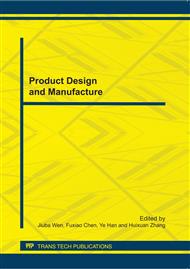p.102
p.108
p.114
p.119
p.129
p.134
p.138
p.144
p.148
Research on Motion Generation for Machining Axisymmetric Aspheric Concave Surface
Abstract:
The positions and orientations of the tool and workpiece are analyzed for machining axisymmetric aspheric concave surface and the position and orientation matrixes of the workpiece and the tool are obtained. The relationship between the tool and the workpiece is set up by using the method of coordinate transformation. The basic modules and the necessary motions for generating axisymmetric aspheric concave surface are clarified. And the possible structural configurations of the machine tool are proposed and optimized. The results in this paper facilitate the innovation design of a machine tool for generating axisymmetric aspheric concave surface.
Info:
Periodical:
Pages:
129-133
Citation:
Online since:
October 2011
Authors:
Price:
Сopyright:
© 2012 Trans Tech Publications Ltd. All Rights Reserved
Share:
Citation:


